Human Orbital Spaceflights
![]()
International Flight No. 136STS-37Atlantis (8)39th Space Shuttle missionUSA |
 |
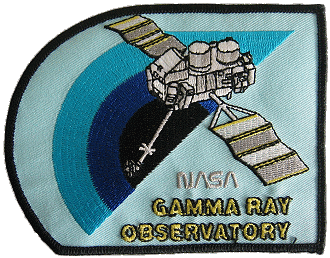 |
|
Source: www.spacepatches.nl |
||
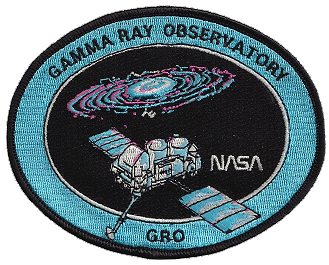 |
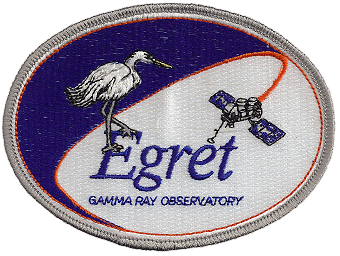 |
|
![]()
Launch, orbit and landing data
walkout photo |
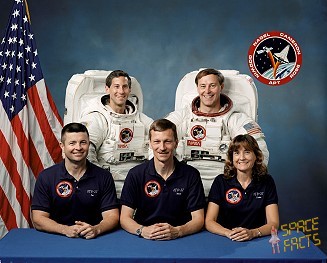 |
||||||||||||||||||||||||||||
alternative crew photo |
Crew
| No. | Surname | Given names | Position | Flight No. | Duration | Orbits | |
| 1 | Nagel | Steven Ray | CDR | 3 | 5d 23h 32m 44s | 93 | |
| 2 | Cameron | Kenneth Donald | PLT | 1 | 5d 23h 32m 44s | 93 | |
| 3 | Godwin | Linda Maxine | MS-1, RMS | 1 | 5d 23h 32m 44s | 93 | |
| 4 | Ross | Jerry Lynn | MS-2, EV-1, FE | 3 | 5d 23h 32m 44s | 93 | |
| 5 | Apt | Jerome "Jay" | MS-3, EV-2 | 1 | 5d 23h 32m 44s | 93 |
Crew seating arrangement
|
 |
|
||||||||||||||||||||||||
Hardware
| Orbiter : | OV-104 (8.) |
| SSME (1 / 2 / 3): | 2019 (8.) / 2031 (5.) / 2107 (4.) |
| SRB: | BI-042 / RSRM 14 |
| ET: | ET-37 (LWT-30) |
| OMS Pod: | Left Pod 01 (14.) / Right Pod 01 (14.) |
| FWD RCS Pod: | FRC 4 (8.) |
| RMS: | 303 (2.) |
| EMU: | EMU No. 2009 (PLSS No. 1006) / EMU No. 2011 (PLSS No. 1013) / EMU No. 2014 (PLSS No. 1008) |
Flight
|
Launch from Cape Canaveral (KSC) and
landing on the Edwards
AFB, Runway
33. Resumption of the countdown after the T-9-minute hold was delayed about 4 minutes 45 seconds because of two possible weather-condition violations of the launch commit criteria (LCC). The first concerned the cloud ceiling being 500 feet (152.4 meters) less than the minimum of 8000 feet (2,438 meters) for a return-to-launch-site (RTLS) abort, and the second concerned the possible weather-condition (wind) effects on blast propagation. Both conditions were found acceptable and the launch countdown proceeded to a satisfactory launch Main goal of this mission was to deploy the Gamma Ray Observatory (GRO), a spacewalk as part of the Extravehicular Activity Development Flight Experiments (EDFE) and to carry several secondary experiments including the Bioserve ITA Materials Dispersion Apparatus (BIMDA), a study in biomedical materials processing; Protein Crystal Growth-III (PCG-III), another in a sequence of Shuttle experiments that grow crystals in weightlessness; the Shuttle Amateur Radio Experiment-II (SAREX-II), an experiment that allowed the crew to contact amateur radio operators around the world who are within range of the Shuttle's flight path; the Space Station Heat Pipe Advanced Radiator Element-II (SHARE-II), a study of an evolving design of cooling radiators for Space Station Freedom; and the Radiation Monitoring Equipment-III (RME-III), a monitor of the amount of radiation penetrating the Shuttle's crew compartment during the flight. The deployment of the Gamma Ray Observatory (GRO) was on schedule for flight day three. GRO, which weighed just over 35,000 pounds (15,876 kilograms), was the heaviest NASA science satellite ever deployed by the Space Shuttle into low-Earth orbit. GRO was a space-based observatory designed to study the universe in an invisible, high-energy form of light known as gamma rays. Although a variety of smaller satellites and high-altitude balloons have carried instruments to study the universe in gamma-ray light during the past 30 years, GRO represents a dramatic improvement in sensitivity, spectral range and resolution. Gamma-rays, which cannot penetrate the Earth's atmosphere, are of interest to scientists because these rays provide a reliable record of cosmic change and evolution. Their study will yield unprecedented answers about the structure and dynamics of the Milky Way Galaxy, the nature of pulsars, quasars, black holes and neutron stars, as well as clues about the origin and history of the universe itself. The four instruments on GRO were selected by NASA to provide the first comprehensive, coordinated observations of a broad gamma-ray energy range with much better sensitivity than any previous mission. The instruments include: the Burst and Transient Source Experiment (BATSE), the Oriented Scintillation Spectrometer Experiment (OSSE), the Imaging Compton Telescope (COMPTEL) and the Energetic Gamma Ray Experiment Telescope (EGRET). The Gamma Ray Observatory was the first scientific payload with a refuelable onboard propulsion system. In addition, GRO provided the support and protection necessary for the observatory to complete its mission. The spacecraft's subsystems include propulsion, power, controls, electronics, communications and thermal. The Gamma Ray Observatory had a self-contained propulsion system that will allow controllers on the ground to keep the GRO spacecraft at the proper altitude. The propulsion system provides thrust for orbit altitude change, orbit maintenance, attitude control and if necessary, controlled reentry. The primary purpose of the Attitude Control and Determination (ACAD) subsystem was to point the GRO instruments to selected celestial gamma-ray sources and to supply attitude information for data processing. The ACAD subsystem was a three-axis system made up of many NASA standard components and other flight-proven hardware. The system contained sensors that tell GRO where it's pointed and actuators for vehicle orientation. The Communications and Data Handling (CADH) system was based on the standard NASA modular design used with great success on the Solar Maximum Mission and Landsats 4 and 5. By using modules, repair of damaged or defective components is vastly simplified. The CADH subsystem consisted of the CADH module, a 60-inch (152 centimeter) high-gain antenna, two omnidirectional low-gain antennas and a radio frequency combiner to interface the module with the antennas. The Observatory's solar arrays were accordion style, multi-panel, rigid arrays, deployed by motor-driven rigid booms. The total power available for the observatory from the solar arrays was approximately 2000 watts. The thermal control of the observatory's subsystems and instruments was accomplished by coatings, blankets, louvers, radiators and heaters. The instruments were thermally isolated from each other and the spacecraft structure to reduce temperature. The four instruments on GRO were essentially telescopes for seeing gamma-ray light, they do not look like ordinary telescopes. Instead, the GRO instruments observed gamma rays indirectly, by monitoring flashes of visible light, called scintillations, that occur when gamma rays strike the detectors (made of liquid or crystal materials) built into the instruments. The Burst and Transient Source Experiment (BATSE) was developed to continuously monitor a large segment of the sky for detection and measurement of short, intense bursts and other transient sources of gamma rays. BATSE consisted of 8 identical detectors, with one detector located at each corner of the spacecraft to give it a very wide field of view. BATSE worked in the low-energy part of the gamma-ray range (20,000 to 2 million eV) in which bursts were expected. The Naval Research Laboratory (NRL), Washington, D.C., designed the Oriented Scintillation Spectrometer Experiment (OSSE) to detect nuclear-line radiation and emissions associated with low energy gamma-ray sources (100,000 to 10 million eV). OSSE was sensitive to the spectral signature of radioactive elements. This enabled OSSE to study supernovae and novae which are believed to be the sites where the heavy elements are created. These elements are the basis for life as we know it. OSSE also provided insight into various types of science targets, such as neutron stars, black holes, pulsars and quasars. The Imaging Compton Telescope (COMPTEL), developed as a cooperative effort by the Federal Republic of Germany, The Netherlands, the European Space Agency and the United States, was designed for observations at moderate gamma-ray energies (1 to 30 million eV). Because COMPTEL had a wide field of view (though not as wide as BATSE) and could locate gamma ray sources, one of its primary functions was to produce a detailed map of the sky as seen in moderate gamma rays. The Energetic Gamma Ray Experiment Telescope (EGRET) was between 10 and 20 times larger and more sensitive than any high energy, gamma-ray telescope previously flown in space. The mission of EGRET, a joint effort by scientists and engineers at NASA's Goddard Space Flight Center (GSFC), Greenbelt, Md.; Stanford University, Stanford, Calif.; Max Planck Institute, Germany; and Grumman Aerospace Corp., Bethpage, NY, was to search the cosmos for high energy gamma-rays. One of its primary missions was to generate a map of the sky as seen in high-energy gamma rays, complementing the map produced by COMPTEL. Another was to discover and monitor gamma-ray emissions from pulsars. The deployment procedure under the lead of Linda Godwin went smoothly until the high-gain antenna of GRO should be deployed. After six failed attempts to deploy the satellite's high-gain antenna, repeated commands by ground controllers at the Payload Operations Control Center, Goddard Space Flight Center, Greenbelt, MD, and maneuvering of Atlantis and its Remote Manipulator System (RMS) robot arm, as well as GRO's antenna dish, were to no avail in dislodging the boom, there was a need of an unscheduled EVA performed by Jerry Ross and Jerome Apt on April 07, 1991 (4h 26m) to free and deploy the failed GRO high-gain antenna. The spacewalk began with Jerry Ross moving down the starboard slidewire and Jerome Apt moving down the port. Seventeen min into the spacewalk, with Atlantis passing through night, Jerry Ross shoved loose the boom by exerting about 27 kg (60 lb) of force using his right hand while holding onto a GRO flight support structure trunnion with his left. The astronauts then set up a foot restraint so they could continue manual deployment, a procedure they had practiced four times in the WETF. The procedure involved removing a pin, pulling the antenna to fully deployed position, and using a wrench to lock the boom. Jerome Apt monitored Jerry Ross' movements so that he did not inadvertently damage GRO. Both astronauts had difficulty finding handholds on GRO in darkness. As Atlantis emerged into daylight, they performed some of the EVA Development Flight Experiment activities originally scheduled for April 08, 1991. They evaluated handrails (the dog bone cross section design proves superior to the round cross-section design); used the Crew Loads Instrumented Pallet (CLIP) to measure forces placed on foot restraints by simple tasks; and moved along a rope extended across the payload bay. They returned to the airlock but did not repressurize it until GRO was successfully away. Jerry Ross and Jerome Apt stuck their helmeted heads out the airlock hatch to watch GRO shrink into the distance. GRO was the second of NASA's four Great Observatories. The Hubble Space Telescope, deployed during Mission STS-31 in April 1990, was the first. GRO was launched on a two-year mission to search for the high-energy celestial gamma ray emissions, which cannot penetrate Earth's atmosphere. It was also designed to be the first satellite that could be refueled in orbit by Shuttle crews. Five months after deployment, NASA renamed the satellite the Arthur Holly Compton Gamma Ray Observatory, or Compton Observatory, after the Nobel Prize-winning physicist who did important work in gamma ray astronomy. A second (scheduled) EVA by Jerry Ross and Jerome Apt occurred on April 08, 1991 (5h 47m) to test moving themselves and equipment for the planned ISS. During the spacewalk, Jerry Ross and Jerome Apt tested several different translation devices which should be the predecessors of devices to be used on Space Station Freedom. The flight tests should answer questions including the speed of translation, complexity of equipment required, ease of translation and crew loads applied to tools and equipment for future EVA experiences. The EVA Developmental Flight Experiment (EDFE) is composed of three sets of evaluations: the Crew and Equipment Translation Aid (CETA); the Crew Loads Instruments Pallet Experiment (CLIP), also known as Detailed Test Objective (DTO) 1203; and the EVA Translation Evaluation, DTOs 1202 and 1205. EDFE experiments required the use of a data recording system, called the Portable Data Acquisition Package (PDAP), that collected information on stresses imparted to the track and cart by the astronauts. The system also measured forces and torque imparted to the tools the astronauts use during the CLIP experiment. CETA consisted of three carts and a tether Shuttle that move down a 46.8-foot (14.27 meters) track mounted on the port side of the payload bay. While the Gamma Ray Observatory was in the payload bay, the track was stored in two 23.4-foot (7.13 meters) sections in the forward part of the bay. Crew members extended the track to the test position at the onset of the EVA and stow it after the evaluations are complete. For each evaluation, the three CETA carts were mounted to a common truck attached to the translation track. The truck was an approximately 20-inch (0.5 meter) square assembly with four roller clusters that ride on the track. The individual carts were fixed to the truck for each evaluation and each has its own brake. The first cart to be tested was the manual configuration. Once positioned in the foot restraints, the astronaut propelled himself, hand over hand, down the rail. Both the tether Shuttle and the manual cart configuration were baselined for the planned Space Station Freedom. The mechanical version resembled a railroad car mechanism with which the astronaut pumped a T-handle to move. This motion was converted by a gear train into the continuous motion of two-wheel drives. A leg restraint connected to the CETA truck and the tether Shuttle to keep the astronaut in a nearly prone position while pumping the cart. The final CETA cart used electrical currents, generated by the astronaut, to move the truck down the rail. The astronaut placed himself in foot restraints and pumps two handles in a bicycle-like motion to create a maximum of 24 volts to drive two small motors. The motors then propelled the truck down the track. Maximum speed for all three carts was 6 feet (1.83 meter) per second. Jerome Apt and Jerry Ross both evaluated all three vehicles, at times carrying each other to simulate transporting cargo to a work station. Although all three methods worked, the astronauts reported that propelling the cart manually or hand-over-hand worked best. Following the CETA evaluation, Jerry Ross and Jerome Apt began working with the scheduled DTOs. CLIP consisted of three force torque sensor plates, a soft stowage assembly and a foot restraint system. The CLIP assembly was stowed on the forward port side of the payload bay. Crew members performed specific tasks that represent those used during normal EVAs, such as tightening a bolt or turning a knob. The foot restraint and work site were instrumented with sensors that measured the crew induced loads to force and moment signals recorded on the PDAP. Most of the tasks required for the CLIP evaluations were repeated twice by both EVA astronauts, for a total of about 80 tasks each. ETE obtained crew translation data for EVA systems requirements definition, technique development and equipment design. The ETE used Shuttle hardware such as a manipulator foot restraint and an EVA force measurement tool with various standard orbiter hardware such as the remote manipulator system and the RMS rope reel to evaluate translation rates and techniques. The BioServe ITA Materials Dispersion Apparatus (BIMDA) primary elements, developed by ITA, were the Materials Dispersion Apparatus (MDA) minilabs and their controller with a self-contained power supply. The MDA minilab was a compact device capable of mixing as many as 150 samples, using liquid-to-liquid processes using two or three fluids, and can grow crystals, cast thin-film membranes and conduct biomedical and fluid science experiments. The MDA experiments included the study of protein crystal growth in space, collagen polymerization, fibrin clot formation, liquid-solid diffusion and the formation of thin film membranes. Another primary element of the BIMDA payload was the bioprocessing testbed, designed and developed by BioServe. The test bed contained the hardware for six bioprocessing modules and six cell syringes. The bioprocessing testbed elements were used to mix cells with various activation fluids followed by extended periods of metabolic activity and subsequent sampling into a fixative solution. The bioprocessing module and cell experiments were to determine the response of live cells to various hormones and stimulating agents under microgravity conditions. The Protein Crystal Growth (PCG) payload aboard STS-37 was a continuing series of experiments leading toward major benefits in biomedical technology. The experiments on this Space Shuttle mission could improve pharmaceutical agents such as insulin for treatment of diabetes. Protein crystals grown on Earth often are small and flawed. The problem associated with growing these crystals is analogous to filling a sports stadium with fans who all have reserved seats. Once the gate opens, people flock to their seats and in the confusion, often sit in someone else's place. On Earth, gravity-driven convection keeps the molecules crowded around the "seats" as they attempt to order themselves. Unfortunately, protein molecules are not as particular as many of the smaller molecules and often are content to take the wrong places in the structure. During the STS-37 flight, experiments were conducted using bovine insulin. Though there are four processes used to grow crystals on Earth - vapor diffusion, liquid diffusion, dialysis and batch process - only batch process will be used in this set of experiments. Shortly after achieving orbit, a crewmember activated the experiment to grow insulin crystals. The STS-26, STS-29, STS-32 and STS-31 experiments were the first opportunities for scientific attempts to grow useful crystals at controlled temperatures by vapor diffusion in microgravity. The STS-37 set of PCG experiments used the batch process and fly in a new hardware configuration, the Protein Crystallization Facility, developed by the PCG investigators. The Space Station Heat Pipe Advanced Radiator Element-II (SHARE-II) was a small middeck experiment that followed up the evolving design of a full-scale heat pipe experiment carried in the payload bay on STS-29. On STS-29, a flight test of a 43-foot (13.11 meters) long heat pipe, a proposed heat-dissipating radiator, found design flaws in the manifold. The manifold is a portion of the radiator that takes ammonia vaporized in an evaporator and moves it through several pitchfork-oriented pipes that converge into one, long single pipe that runs the length of the radiator. The manifold on the original SHARE was designed in a T-shape, with sharp angles that were discovered to block the vapor, thus preventing the radiator from functioning. On STS-37, two small, transparent test articles were flown in a single middeck locker. One test article, representing about a 1.5-foot (0.46 meter) long section of heat pipe, simulated the actual size of the manifold section. The redesigned manifold featured more of a Y-shape convergence of pipes, in theory allowing for easier transportation of the fluid. Conducting short-wave radio transmissions between ground-based amateur radio operators and a Shuttle-based amateur radio operator is the basis for the Shuttle Amateur Radio Experiment (SAREX) flown aboard STS-37. During STS-37, Pilot Kenneth Cameron, a licensed operator (KB5AWP), operated SAREX when he was not scheduled for orbiter or other payload activities. Kenneth Cameron made at least four transmissions to test each transmission mode. The remaining members of the STS-37 crew - Commander Nagel (N5RAW) and mission specialists Linda Godwin (N5RAX), Jerome Apt (N5QWL) and Jerry Ross (KB5OHL) also are licensed ham operators. SAREX previously had flown on missions STS-9, STS-51F and STS-35 in different configurations, including the following hardware: a low-power hand-held FM transceiver; a spare battery set; an interface module; a headset assembly and an equipment assembly cabinet that has been redesigned since its last flight on STS-51F. The cabinet now included the packet system and could hold the camera and monitors. Additional hardware included: a television camera and monitor; a payload general support computer (PGSC); and an antenna which was mounted in a forward flight window with a fast scan television (FSTV) module added to the assembly. Radiation Monitoring Equipment-III (RME-III) measured the rate and dosage of ionizing radiation to the crew at different locations throughout the orbiter cabin. The hand-held instrument measured gamma ray, electron, neutron and proton radiation and calculates the amount of exposure. The information was stored in memory modules for post-flight analysis. RME-III was stored in a middeck locker during flight except for when it was turned on and when memory modules were replaced every 2 days. It was activated as soon as possible after achieving orbit and operated throughout the flight. To activate the instrument, a crew member entered the correct mission elapsed time. The Ascent Particle Monitor (APM) instruments were mounted in Atlantis' payload bay during STS-37 to measure contaminants in the bay during launch and ascent. The APM was a completely automatic system consisting of a small aluminum sample box with doors that opened immediately prior to liftoff. When the doors were opened, 12 sample collection coupons were exposed to gather particles in the environment. The doors close following ascent to protect the samples for analysis after Atlantis has landed. The APM has flown previously on several Shuttle missions and is part of an ongoing effort to better characterize the cargo bay environment during launch. The orbiter also participated in the Air Force Maui Optical System (AMOS), a continuing series of observations of Shuttle orbital engine firings by ground Air Force instruments. The Air Force Maui Optical Site (AMOS) tests allowed ground- based electro-optical sensors located on Mt. Haleakala, Maui, Hawaii, to collect imagery and signature data of the orbiter during cooperative overflights. The scientific observations made of the orbiter, while performing reaction control system thruster firings, water dumps or payload bay light activation, and were used to support the calibration of the AMOS sensors and the validation of spacecraft contamination models. The AMOS tests had no payload unique flight hardware and only required that the orbiter be in predefined attitude operations and lighting conditions. The landing was delayed one day due to weather conditions at the Edwards AFB and Kennedy Space Center (KSC). Due to an incorrect call on winds aloft, Atlantis landed 623 feet (190 meters) short of the runway. This did not present a problem, since the orbiter landed on the dry lake bed of Edwards, and a problem was not obvious to most viewers. Had the landing been attempted at the Kennedy Space Center, the result would have been a touchdown on the paved underrun preceding the runway and would have been much more obvious. |
EVA data
| Name | Start | End | Duration | Mission | Airlock | Suit | |
| EVA | Ross, Jerry | 07.04.1991, 18:?? UTC | 07.04.1991, 22:?? UTC | 4h 26m | STS-37 | Atlantis | EMU No. 2009 |
| EVA | Apt, Jerome | 07.04.1991, 18:?? UTC | 07.04.1991, 22:?? UTC | 4h 26m | STS-37 | Atlantis | EMU No. 2011 |
| EVA | Ross, Jerry | 08.04.1991, 14:51 UTC | 08.04.1991, 20:38 UTC | 5h 47m | STS-37 | Atlantis | EMU No. 2009 |
| EVA | Apt, Jerome | 08.04.1991, 14:51 UTC | 08.04.1991, 20:38 UTC | 5h 47m | STS-37 | Atlantis | EMU No. 2011 |
Photos / Graphics
 |
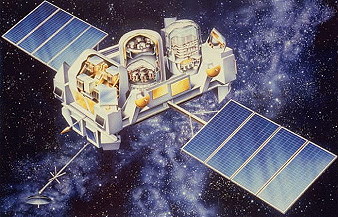 |
 |
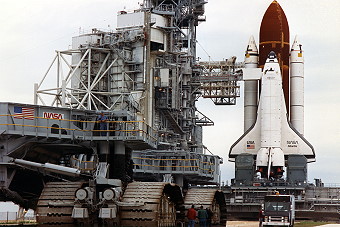 |
 |
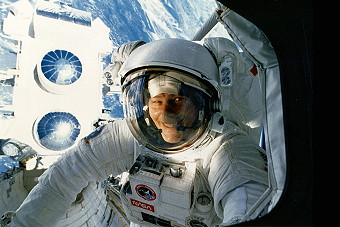 |
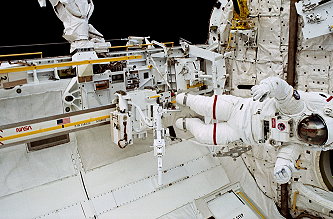 |
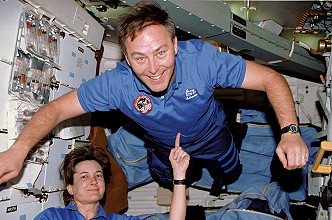 |
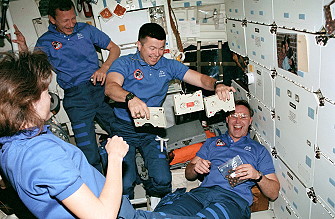 |
 |
 |
 |
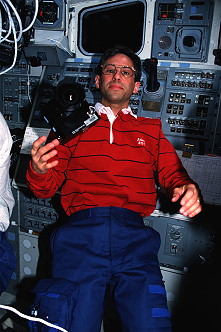 |
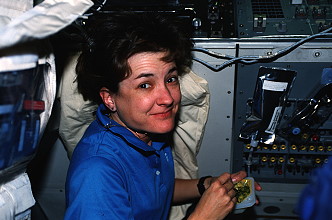 |
 |
 |
more EVA photos |
|
| © |  |
Last update on March 26, 2020.  |
 |